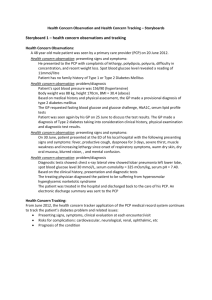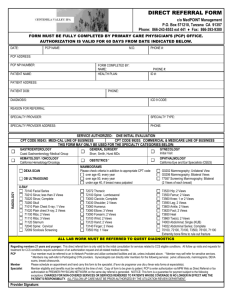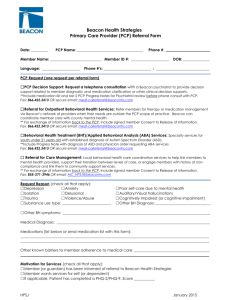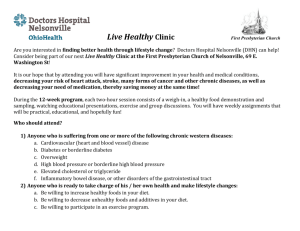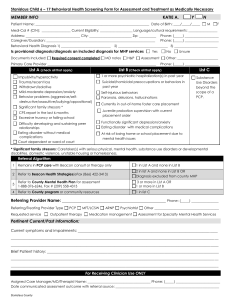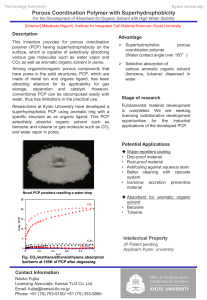abstract
advertisement
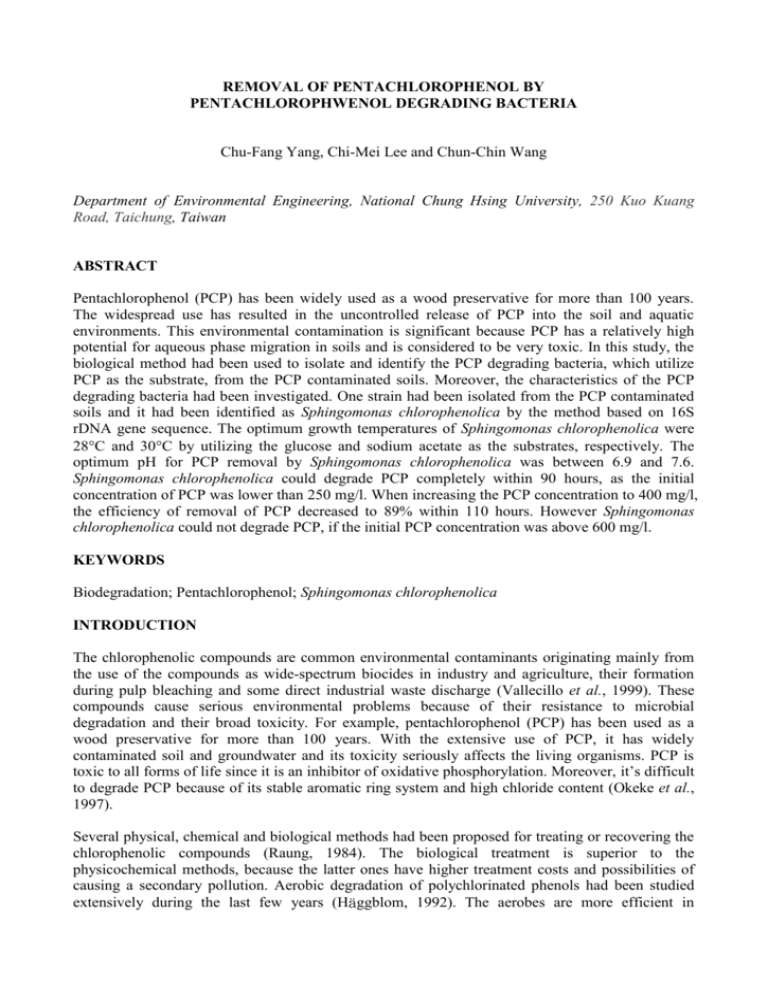
REMOVAL OF PENTACHLOROPHENOL BY PENTACHLOROPHWENOL DEGRADING BACTERIA Chu-Fang Yang, Chi-Mei Lee and Chun-Chin Wang Department of Environmental Engineering, National Chung Hsing University, 250 Kuo Kuang Road, Taichung, Taiwan ABSTRACT Pentachlorophenol (PCP) has been widely used as a wood preservative for more than 100 years. The widespread use has resulted in the uncontrolled release of PCP into the soil and aquatic environments. This environmental contamination is significant because PCP has a relatively high potential for aqueous phase migration in soils and is considered to be very toxic. In this study, the biological method had been used to isolate and identify the PCP degrading bacteria, which utilize PCP as the substrate, from the PCP contaminated soils. Moreover, the characteristics of the PCP degrading bacteria had been investigated. One strain had been isolated from the PCP contaminated soils and it had been identified as Sphingomonas chlorophenolica by the method based on 16S rDNA gene sequence. The optimum growth temperatures of Sphingomonas chlorophenolica were 28C and 30C by utilizing the glucose and sodium acetate as the substrates, respectively. The optimum pH for PCP removal by Sphingomonas chlorophenolica was between 6.9 and 7.6. Sphingomonas chlorophenolica could degrade PCP completely within 90 hours, as the initial concentration of PCP was lower than 250 mg/l. When increasing the PCP concentration to 400 mg/l, the efficiency of removal of PCP decreased to 89% within 110 hours. However Sphingomonas chlorophenolica could not degrade PCP, if the initial PCP concentration was above 600 mg/l. KEYWORDS Biodegradation; Pentachlorophenol; Sphingomonas chlorophenolica INTRODUCTION The chlorophenolic compounds are common environmental contaminants originating mainly from the use of the compounds as wide-spectrum biocides in industry and agriculture, their formation during pulp bleaching and some direct industrial waste discharge (Vallecillo et al., 1999). These compounds cause serious environmental problems because of their resistance to microbial degradation and their broad toxicity. For example, pentachlorophenol (PCP) has been used as a wood preservative for more than 100 years. With the extensive use of PCP, it has widely contaminated soil and groundwater and its toxicity seriously affects the living organisms. PCP is toxic to all forms of life since it is an inhibitor of oxidative phosphorylation. Moreover, it’s difficult to degrade PCP because of its stable aromatic ring system and high chloride content (Okeke et al., 1997). Several physical, chemical and biological methods had been proposed for treating or recovering the chlorophenolic compounds (Raung, 1984). The biological treatment is superior to the physicochemical methods, because the latter ones have higher treatment costs and possibilities of causing a secondary pollution. Aerobic degradation of polychlorinated phenols had been studied extensively during the last few years (Häggblom, 1992). The aerobes are more efficient in degrading the toxic compounds because they grow faster than anaerobes and usually transform the organic compounds to inorganic compounds. Several strains of bacteria that are able to completely mineralize polychlorinated phenols have been described (Bellin et al., 1990). In this study, the biological method has been used to isolate and identify the PCP degrading bacteria, which utilize PCP as the substrate, from the PCP contaminated soils. Moreover, the characteristics of the PCP degrading bacteria have been investigated. MATERIALS AND METHODS Enrichment of mixed culture All microbial enrichment and isolation procedures were performed in media with an inorganic culture media base of the following composition (in grams per liter): MgSO47H2O, 0.2; CaCl22H2O, 0.02; K2HPO4, 0.5; KH2PO4, 0.5; NH4NO3, 0.5; trace element solution, 10 ml/l. The composition of the trace element solution in the inorganic culture media included (in mg per liter): FeSO47H2O, 300; MnSO4H2O, 50; CoCl26H2O, 106; Na2MoO42H2O, 34; ZnSO47H2O, 40; CuSO45H2O, 50. The unsieved soil (6 g) and inorganic culture media (70 ml) were mixed by the waring blender for 1 minute. The mixture culture (8 ml) from the waring blender was added into the flask which contained 80 ml inorganic culture media, and PCP was added to serve as the sole carbon and energy source. The mixture culture was placed on a shaker (120 rpm) in the dark at 30C. The biodegradation of PCP in the flask was monitored periodically. When PCP had been consumed, PCP was added into the flask. This PCP adding procedure was repeated until the degradation of PCP at a stable level. PCP removal by acclimated mixed culture of bacteria In order to understand the ability of acclimated mixed culture degraded PCP, the experiments were conducted with a series of 250 ml batch reactors. Each reactor contained 40 ml of inorganic culture media with mixed culture of bacteria. The amount of mixed culture of bacteria was 10 7 cells/ml. Different concentrations of PCP were added and sealed with cotton stoppers. The reactors were shaken at 120 rpm in the dark at 30C to observe PCP removal under aerobic conditions. Isolation of the bacteria When the mixed culture could degrade PCP at a stable level, a series of dilutions were made and then were spread on R2A plates containing 40 mg/l of PCP to obtain single colonies (the plates were incubated at 30C). The loopfuls of single colony from each plate were streaked onto other fresh R2A plates containing 40 mg/l of PCP to check for purity. After obtaining many pure strains, each strain was checked its ability to degrade PCP. Each pure culture was incubated into 125 ml flask containing 40 ml inorganic culture media and 30 mg/l of PCP, and then the flasks were shaken at 120 rpm in the dark at 30C. The ability of each strain degrading PCP was confirmed by measuring the concentration of PCP in the flask. Identification of the bacteria The DNA of PCP degrading bacteria was extracted from 1.5 ml of enrichment pure culture after pelleting by centrifugation and resuspending the pellet in 150 μl of sterile water. 10l lysozyme (5 mg/ml) was added to break down cell walls; then 40 l of SDS (10%) was added into the tube and incubated at 65C for 30 minutes. After 30 minutes, 20 l of protease K (10 mg/ml) was added to and incubated at 37C for 4 hours; then 400 l of STE buffer was added to the tube. The compositions of STE buffer were: NaCl, 0.1M; Tris-HCl, 10 mM (pH=8.0); EDTA, 1 mM. In order to extract total genomic DNA, equal volumes of phenol-chloroform were added to the tube and the tube was centrifuged at 12000 rpm for 5 minutes; then the supernatant was added to the new microcentrifuge tube. The procedure of extraction repeated three times until the impurity material reduced minimal. After extraction, 50l of sodium acetate (3 M, pH=5.2) and 1 ml of ethanol (3 M, pH=5.2) were added into supernatant for 10 minutes, and then tip was used to roll up the bacterial genomic DNA from the tube. Finally, the bacterial genomic DNA on the tip was transferred into 70 l of H2O to further amplification of the 16S ribosomal genes. The 16S ribosomal genes were amplified from the bacterial total genomic DNA by using the polymerase chain reaction (PCR). A 5 l purified extracted DNA served as the template in a PCR reaction mixture with the modified amplification primer 27f (5’-GAGTTTGATC(AC)TGGCTCA G-3’) and 1492r (5’-TACGG(CT)TACCTTGTTACGACTT-3’) (Byers et al., 1998). Each 200l microtube contained 5l purified extracted DNA; 2l of dNTP at 2.5 mM; 2.5l of 10X Taq DNA polymerase buffer; 0.2l of 2.5 unit Taq DNA polymerase; 11.3l of sterile water and 2l of the modified amplification primers (total amount: 10 pmol). The PCR was performed in a GeneAmp PCR system 2400 thermal cycler with a hot starting performed at 94C for 5 minutes, followed by 30 cycles of 94C for 1 minute, 55C for 1 minute, and 72C for 2 minutes, followed by a final extension performed at 72C for 10 minutes. The 16S rDNA was purified using Viogene’s Gel Extraction System (gel extraction miniprep kit) and sequencing was performed at National Chung Hsing University Biotechnology Center (Taichung, Taiwan). The 16S rDNA sequence was compared against the GenBank database using the NCBI Blast program. The experiment of optimum temperature for growth The L-type tubes were used which containing 10 ml inorganic culture media and cell suspensions. After adding 400 mg/l of substrate (glucose or sodium acetate) and sealing with cotton stoppers, the L-type tubes were shaken in the temperature gradient incubator (TEMPERATURE GRADIENT INCUBATOR 12, TOYO®). Optical density at 600 nm was followed as a measurement of growth. The specific growth rate was then plotted versus temperature of incubation to obtain the optimum temperature for growth. The experiment of optimum pH for PCP removal by pure culture of bacteria In order to find out the optimum pH for PCP removal, various pHs of inorganic culture media (pH=5.2, 6.0, 6.9, 7.6, 8.3, 9.2) were prepared. The pHs of inorganic culture media were adjusted with NaOH/HCl. Each 125 ml batch reactor contained 40 ml inorganic culture media with cell suspensions containing 107 cells/ml, and then 75 mg/l of PCP was added to serve as the sole carbon and energy source. After sealing with cotton stoppers, the reactors were shaken at 120 rpm in the dark at 30C to observe PCP removal under aerobic conditions. The PCP removal by pure culture of bacteria The PCP removal by pure culture of bacteria was investigated using the same setup with the exception that pure culture of bacteria replaced mixed culture of bacteria. Analytical methods The cell suspensions were clarified by centrifugation at 8000 rpm for 3 minutes. The cell-free supernatant fraction was analyzed by high performance liquid chromatography (HPLC) with ultraviolet detector. HPLC was performed with a Hitachi system equipped with a Merck Lichrospher 100 PR-18 endcapped (5 m) column at a flow rate of 0.8 ml/min. The ratio of solvent system was acetonitrile: water: phosphoric acid= 65: 35: 0.1. The UV detector absorbency wavelength was fixed at 284 nm. The pH and O.D. were measured using a pH meter and Spectrophotometer at 600 nm, respectively. RESULTS AND DISCUSSION The PCP removal by acclimated mixed culture of bacteria Figure 1 shows the removal of different concentrations of PCP by acclimated mixed culture in 250ml flasks. The results indicated that PCP concentrations less than 200 mg/l were degraded completely by acclimated mixed culture. When the initial PCP concentrations were 10 mg/l, 25 mg/l, 50 mg/l, 100 mg/l, and 200 mg/l, the mixed culture of bacteria could remove the PCP completely within 27 hours, 35 hours, 35 hours, 45 hours and 53 hours, respectively. However, while the PCP concentration was above 100 mg/l, the removal of PCP by the mixed culture had a longer lag period. There was no significant variation of O.D. value and pH value during the experiment period (data not shown), as the PCP concentration was below 50 mg/l. While the PCP concentration was above 100 mg/l, the pH value decreased obviously. The O.D. value did not increase in the same condition (data not shown). The possible reason might be that the intermediates which were transformed from PCP inhibited the growth of PCP non-degrading bacteria. The isolation and identification of PCP degrading bacteria PCP conc. (mg/l) At first the mixed culture of bacteria were acclimated to 30 mg/l of PCP for 3 months. However, all the ten strains which were isolated from the mixed culture with nutrient agar (NA) plates could not degrade 10 mg/l of PCP within 2 months. The possible reason was that the ten strains could tolerate 200 180 160 140 120 100 80 60 40 20 0 10 mg/l 25 mg/l 50 mg/l 100 mg/l 200 mg/l 0 10 20 30 40 50 60 70 80 90 time (hr) Fig. 1. The removal of different concentrations of PCP by acclimated mixed culture of bacteria in a batch reactor. the toxicity of low PCP concentration but did not degrade the PCP. Therefore, the PCP acclimated concentration was increased to 800 mg/l and the acclimated time reduced to 3 weeks. After 3 weeks, eight strains were isolated from the acclimated mixed culture of bacteria by using NA plate. All the eight strains still had no ability to remove PCP. We assumed that PCP degrading bacteria might grow slower than PCP non-degrading bacteria on NA plate. For this reason, the R2A plate replaced the NA plate for isolation. Thirteen strains were isolated from the R2A plate, which was spread with 40 mg/l of PCP on the surface, and one of them could remove 50 mg/l of PCP. This strain was identified as Sphingomonas chlorophenolica by methods based on 16S rDNA gene sequence. The optimum growth temperature of Sphingomonas chlorophenolica 0.14 (a) 0.12 0.1 0.08 0.06 0.04 0.02 Specific growth rate (1/hr) Specific growth rate (1/hr) Figure 2 shows the specific growth rate of Sphingomonas chlorophenolica with different temperatures. The results indicated that the optimum growth temperature of Sphingomonas chlorophenolica was 28C by utilizing 400 mg/l of glucose as substrate [Fig. 2(a)]. While the substrate was sodium acetate, the optimum growth temperature of Sphingomonas chlorophenolica was 30C [Fig. 2(b)]. Sphingomonas chlorophenolica was mesophilic bacterium. 0.12 (b) 0.1 0.08 0.06 0.04 0.02 0 0 0 5 10 15 20 25 30 35 40 45 50 55 temperature (℃) 0 5 10 15 20 25 30 35 40 45 50 55 temperature (℃) Fig. 2. The specific growth rate of Sphingomonas chlorophenolica with different temperature. (a) glucose as substrate (b) sodium acetate as substrate The optimum pH for PCP removal by Sphingomonas chlorophenolica The removal of 75 mg/l of PCP by Sphingomonas chlorophenolica with different initial pH value was shown in Figure 3. When the initial pH value was 6.9, 7.6 and 8.3, Sphingomonas chlorophenolica could remove the PCP completely within 37 hours, 37 hours and 87 hours, respectively. The removal efficiency of PCP was 90% at the end of experiment (282.2 hours), as the initial pH value was 9.2. Sphingomonas chlorophenolica could not remove the PCP, while the initial pH value was below 6.0. Therefore, the optimum pH for PCP removal by Sphingomonas chlorophenolica was between 6.9 and 7.6. The PCP removal by Sphingomonas chlorophenolica Figure 4 shows the removal of different concentrations of PCP by Sphingomonas chlorophenolica in 250-ml flasks. In batch culture, Sphingomonas chlorophenolica was capable of completely degrading PCP at a concentration lower than 250 mg/l. When the initial PCP concentrations were 100 mg/l and 250 mg/l, Sphingomonas chlorophenolica could remove the PCP completely within 25 hours and 90 hours, respectively. At the concentration greater than 400 mg/l, degradation of PCP was not complete. While the PCP concentration increased to 400 mg/l, the removal efficiency for PCP was 89% at 110 hours and the removal efficiency for PCP maintained constant after 110 hours. PCP conc. (mg/l) 80 70 60 50 40 30 20 10 0 0 50 100 150 time (hr) pH=6.0 pH=8.3 pH=5.2 pH=7.6 200 250 300 pH=6.9 pH=9.2 PCP conc. ( mg/l ) Fig. 3. The removal of 75 mg/l of PCP by Sphingomonas chlorophenolica in a batch reactor with different pH value. 900 800 700 600 500 400 300 200 100 0 0 50 100 mg/l 600 mg/l 100 150 time ( hr ) 250 mg/l 800 mg/l 200 250 400 mg/l Fig. 4. The removal of different concentrations of PCP by Sphingomonas chlorophenolica in a batch reactor. The possible reason that Sphingomonas chlorophenolica could not remove the PCP completely was that the lower pH inhibited the activity of Sphingomonas chlorophenolica. When initial PCP concentration was 400 mg/l, pH decreased from 7.8 to 5.36 (data not shown). Sphingomonas chlorophenolica could not degrade the PCP, when the PCP concentration was above 600 mg/l. Figure 4 showed that the lag phase increased exponentially with increasing initial PCP concentration. The possible reason was that the amount of PCP degrading enzyme needed more time to produce. While the initial PCP concentrations were 100 mg/l, 250 mg/l and 400 mg/l, the O.D.600 values of Sphingomonas chlorophenolica were 0.125, 0.117 and 0.201 at the end of study, respectively (data not shown). As the PCP concentration was below 250 mg/l, the O.D. value of Sphingomonas chlorophenolica was very low during the experiment period. The possible reason might be that the amount of PCP was insufficient for Sphingomonas chlorophenolica growth. Figure 1 and Figure 4 showed that the removal rate of PCP by Sphingomonas chlorophenolica was better than the acclimated mixed culture of bacteria, when the initial PCP concentration was below 100 mg/l. But when the initial PCP concentration was as high as 200 mg/l, the PCP removal rate by Sphingomonas chlorophenolica was similar to the acclimated mixed culture of bacteria. Radehaus and Schmide isolated a PCP-degrading bacterium from polluted soil and identified it as Pseudomonas sp. strain RA2. When the initial PCP concentrations were 40 mg/l and 150 mg/l, the removal efficiency of PCP were 95% at 96 hours and 97% at 192 hours, respectively. At a PCP concentration of 200 mg/l, cell growth was completely inhibited and PCP was not degraded (Radehaus and Schmide, 1992). In this study, Sphingomonas chlorophenolica could remove 100 mg/l and 250 mg/l of PCP completely within 25 hours and 90 hours, respectively (Fig. 4.). It indicated that the removal efficiency of PCP by Sphingomonas chlorophenolica was better than Pseudomonas sp. strain RA2. CONCLUSIONS AND PERSPECTIVES The purposes of this study were to isolate the PCP degrading bacteria from the PCP contaminated soils, and to investigate the characteristic of the PCP degrading bacteria. The conclusions derived from this study were as follows: 1) As the PCP concentration was below 200 mg/l, the mixed acclimated culture of bacteria could remove the PCP completely within 55 hours. 2) One strain was isolated from the acclimated mixed culture and this strain was identified as Sphingomonas chlorophenolica by methods based on 16S rDNA gene sequence. 3) The optimum growth temperature of Sphingomonas chlorophenolica was 28C by utilizing 400 mg/l of glucose as substrate. If the substrate was sodium acetate, the optimum growth temperature of Sphingomonas chlorophenolica was 30C. The optimum pH for PCP removal by Sphingomonas chlorophenolica was between 6.9 and 7.6. 4) When the initial PCP concentrations were 100 mg/l and 250 mg/l, Sphingomonas chlorophenolica could remove PCP completely within 25 hours and 90 hours, respectively. The removal efficiencies were 89% for 110 hours, as the initial PCP concentration was 400 mg/l. However, Sphingomonas chlorophenolica could not degrade PCP while the initial PCP concentration was above 600 mg/l. 5) The removal rate of PCP by Sphingomonas chlorophenolica was better than the acclimated mixed culture of bacteria, when the initial PCP concentration was below 100 mg/l. But when the initial PCP concentration was as higher as 200 mg/l, the PCP removal rate by Sphingomonas chlorophenolica was similar to the acclimated mixed culture of bacteria. ACKNOWLEDGEMENT The author wouled like to thank the National Science Council of the republic of china (Taiwan) for their support to this research by contract : NSC 89-2815- C005-067R-E. REFERENCES Bellin C. A., O'Connor G. A., Jin Y. (1990) Sorption and degradation of pentachlorophenol in sludge-amended soils. J. Environ. Qual. 19, 603-608. Byers H. K., Stackebrandt E., Hayward C., Blackall L. L. (1998) Molecular investigation of a microbial mat associated with the great artesian basin. FEMS Microbiology Ecology 25, 391403. Häggblom M. M. (1992) Microbial breakdown of halogenated aromatic pesticides and related compounds. FEMS Microbiol. Rev. 103, 29-72. Okeke B. C., Paterson A., Smith J. E., Watson-Craik I. A. (1997) Comparative biotransformation of pentachlorophenol in soils by solid substrate cultures of Lentinula edodes. Appl. microbiol. biotechnol. 48, 563-569. Radehaus P. M., Schmidt S. K. (1992) Characterization of a novel Pseudomonas sp. that mineralizes high concentrations of pentachlorophenol. Appl. Environ. microbiol. 58, 2879-2885. Raung K. D. (1984) Theory and practice for the removal of phenols in wastewater. Indust. Poll. Prevent. and Control 3, 88-103. Vallecillo A., Garcia-Encina, Peña M. (1999) Anaerobic biodegradability and toxicity of chlorophenols. Water sci. technol. 40, 161-168.


